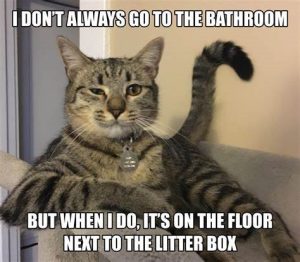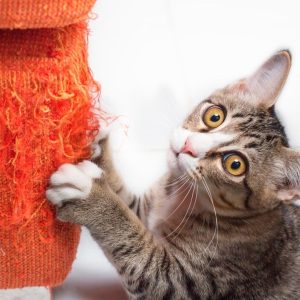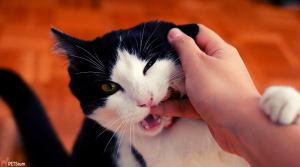
We love our kitties, but sometimes they can be downright frustrating, whether they are treating the expensive sofa like a cat scratching post or refusing to use their litter box! Here is a list of the 5 most common kitty behavior problems and tips to help solve them!
#1 – Not Using the Litter Box

Cats have a reputation for being easy to litter train, but sometimes they will go in other places besides their designated box. Litterbox troubles happen for many reasons including an undiagnosed medical issue, unwelcome changes to their environment and dissatisfaction with their current litterbox. Most refusals to use the box are stress-related, so try not to punish you cat as this will just increase the stress they are feeling and worsen the behavior. You may have to entertain several possibilities before discovering the reason behind your cat’s refusal to use their box, but most problems are easy to rectify.
First, you will want to take your cat to the vet to eliminate any health concerns. Then, think if there have been any changes to your cat’s environment lately – have you moved their box or changed the type/brand of litter, has there been a new addition to the household or is there a feral cat hanging out by the house. Once you have eliminated these bigger issues, you can begin experimenting with adjusting other smaller things that may have a big impact like
- Availability: Make sure you have enough boxes in your home. It is standard to have 1 more box than the number of cats in the home. This keeps things cleaner and provides more options, especially if one cat is feeling bullied by another in the home or if they prefer to urinate in one and defecate in another. If you already offer this, and they are going outside of the box, it never hurts to add another box.
- Location: Just like us, cats desire a bit of privacy when doing their business so place the boxes in an out of the way, low traffic area. You’ll also want to spread the boxes throughout the home, not next to one another, on different floors for example. Some are just picky though and may not prefer the locations you chose. So if they are going elsewhere, try moving at least one of the boxes.
- Cleanliness: You should be scooping your cat’s boxes once a day at a minimum. Not only does it provide a cleaner bathroom for them, seeing their daily output is also one of the best ways to monitor your cat’s health. And cats are very clean creatures. Making sure it is a clean space will increase the likelihood of its use.
- Litter Type: If you have changed the type or brand of litter recently, that could be the problem. Even if you haven’t, some cats build an aversion to a litter after many years of using the same thing. Experiment and find out what your cat likes best remembering that cats have sensitive noses and are not fond of perfume and chemical scents. The most appealing type of litter to most cats is unscented clumping litter that’s the consistency of fine sand. It’s best to purchase different types, though, and offer them side by side to let your cat choose. If you need to change to another type of litter, do it gradually by adding a little more of the new product each time you change the litter, until your kitty is used to the new litter.
- Box Type: Many commercial litter boxes are too small for an adult cat to comfortably maneuver, so try a large shallow plastic storage bin and see if more room makes a difference. Some cats, especially senior ones, have difficulty scaling the high walls on the sides of the box, so a more shallow box may do the trick. Other times, a cat may not like feeling cramped or closed in by boxes with covers. Plus, those covers trap odors which can make the box less desirable. So if your box has a hood, try removing it and see what happens.
#2 – Scratching Furniture or Carpet

Scratching is a natural behavior cats use to communicate, claim territory, relieve stress, stretch their bodies and condition their claws, but there is nothing more aggravating than seeing everything from your sofa to your table legs destroyed by your cat. So how can you encourage them to only scratch appropriately?
- Have scratching posts available: Get sturdy scratching posts and position them to protect your furniture. A post will keep your kitty occupied and let them satisfy their scratching urges.
- Use positive reinforcement: Encourage your cats to use designated scratch zones with treats and affirmation.
- Redirect their attention: Discourage your cats from scratching your couch by diverting their focus. Make a loud noise to grab their attention and then use a toy or treat to direct them to the scratching post.
Keep your cat’s claws trimmed, too. You can ask a groomer or veterinary assistant to trim their claws regularly or have them show you how to do it correctly on your own.
And, if nothing deters the behavior, you can purchase claw caps, silicone covers that slip over your kitty’s sharp claws.
#3 – Eating your houseplants

Look at a cat in the wild and you will notice that they munch on anything that offers some nutrition. Even big cats that prefer meaty main courses will occasionally nibble on some greens. So what do you do if your cat won’t stop making a snack out of your plants?
- Get a Check Up: While it is fairly common for cats to nibble on plants, it is important to be aware that this behavior can sometimes indicate an underlying health issue or nutrient deficiency. If your cat consistently chews on plants, it is a good idea to take them to the vet for a check-up to rule out dental problems, digestive issues, and stress.
- Keep It Safe: Make sure to familiarize yourself with what plants are toxic to cats so you don’t bring any in to the house (https://www.aspca.org/pet-care/animal-poison-control/cats-plant-list). And if you do have a plant curious kitty, bring in some cat-friendly houseplants that are safe and fun for them to chew, such as cat grass or catnip.
- Eliminate Boredom: Like most undesired behaviors, this one can also sometimes be attributed to boredom. Your cat may be looking for attention or killing boredom so spend more time with your cat and incorporate at least 2-3 play sessions a day. Leaving some toys out can also help, but of you do this, rotate the toys every few days so they don’t become too familiar causing your cat to ignore them.
#4 – Aggressive Playing

Play aggression in cats involves biting and clawing as well as stalking and attacking people and generally treating people as a cat would treat prey or another cat. This behavior peaks in most cases in the morning and evenings—just like in the hunting world. Play-aggressive cats are usually young and very active; however, even older cats can be playfully aggressive. These cats tend to be very high-energy cats that become easily bored and have a short attention span. They will usually find just about anything to play with and are very rough and intense in their play. Lack of scheduled appropriate playtime is a major factor contributing to play aggression. Play aggression is often exhibited in cats that are ignored or left alone for long periods of time without a human or animal playmate. So here are some things you can do:
- Interactive Play: Interactive toys are the best way to play with your cat as they simulate hunting. They usually feature a fishing pole design with a toy dangling on the end of a string or wire. With interactive toys you can imitate various types of prey: birds, mice, snakes, and bugs. Remember to move the toys like prey, as if they were trying to get away from the hunter. Don’t dangle the prey right in your cat’s face. Oppositely, don’t make it too hard for your cat to catch the toy. You want them to have many successes so that the play is fun and rewarding.
- Solo Play: This depends on the cat’s level of activity and ability to self-entertain, but the most common types of solo toys are ping pong balls, catnip toys, food dispensing toys, and fuzzy mice. They should be light enough for your kitty to bat around since they will have to “bring them to life” by themselves. Toys should be mentally stimulating and rotated regularly to prevent boredom.
- Hands Are Not Toys: Never play roughly with a cat, wrestle with it, or move your hands so that the cat chases them. It is very important whenever you are playing with any cat to use a toy. Even if the rough play, biting, and scratching do not bother the owner, the cat will learn that body parts are toys to bite and scratch.
#5 – Jumping on Counters

Cats are naturally curious and it’s no surprise they want to investigate all parts of their home. But it’s not the safest or healthiest thing to allow them on kitchen counters or tabletops. So how can you stop this behavior?
- Make Them Less Tempting: Cats jump and climb out of curiosity, so make sure to keep your counters clear of any objects they can easily bat around and any food items that could entice them.
- Use Deterrents: If you have a curious cat that likes to jump and climb, consider a simple deterrent. Lining the counter with aluminum foil or baking paper will make a sound when your cat lands. This will startle them slightly, but not enough to physically harm them. They will eventually associate the startling sound with jumping on the counter and it will deter them from jumping in the future. You can also use citrus-scented cleaning products since as mentioned earlier, cats do not like citrus smells.
- Offer Alternatives: As natural climbers, cats crave vertical challenges and will be drawn to high locations. So, make sure they have other vertical spaces to explore besides your tables and counters by offering cat trees, towers, bridges and the like in different parts of your home.
- Train a Different Behavior: If your kitty wants to be with you and see what you are up to in the kitchen, pick a desired location for them to hang out like a specific mat on the floor, stool, chair, or cat shelf and reward your cat for sitting there. The more they are rewarded for this behavior the sooner they with realize this is the place you’d like them to be to spend time together when in the kitchen.

Maybe there’s no such thing as a bad kitty in your book, but some cats do have behavior problems that call for extra support, care and attention. Hopefully these tips can improve some of those pesky behaviors that drive cat parents across the globe crazy!





Leave a Reply